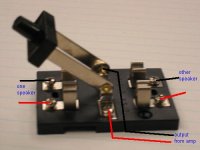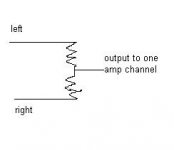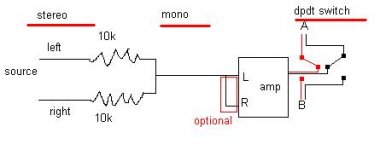I know this is a stupidly simple question, but I really do not know anything about what would be safest for my equipment in this instance.
Since my amp died, I no longer have the ability to do fast AB switching of single speakers. I have now ordered a new amp (SI Super-T), and I need to build a switch box so I can continue doing AB testing of my prototypes. When not in use, the switch will be disconnected.
Because I'm only switching between two speakers, I need to sum the stereo out from the amp into a mono signal, so I will splice two blacks plugs for the neg terminals and two red plugs for the pos terminals on the amp. That gives me a mono signal. I then want that wire to go to a switch box that will switch between two separate outs, one going to each speaker. So one speaker wire in (- and +) and two wires out.
My question is what kind of switch do I get? I'm mostly concerned about protecting the amp and the speakers from damage, and I want it to be as sonically neutral as possible.
Thanks for any advice on this.
Doug
Since my amp died, I no longer have the ability to do fast AB switching of single speakers. I have now ordered a new amp (SI Super-T), and I need to build a switch box so I can continue doing AB testing of my prototypes. When not in use, the switch will be disconnected.
Because I'm only switching between two speakers, I need to sum the stereo out from the amp into a mono signal, so I will splice two blacks plugs for the neg terminals and two red plugs for the pos terminals on the amp. That gives me a mono signal. I then want that wire to go to a switch box that will switch between two separate outs, one going to each speaker. So one speaker wire in (- and +) and two wires out.
My question is what kind of switch do I get? I'm mostly concerned about protecting the amp and the speakers from damage, and I want it to be as sonically neutral as possible.
Thanks for any advice on this.
Doug
if the test signal is mono'd before the (pre)amp - I usually use FM tuner, then just plug each channel into alternate channels on sequential inputs ( tuner/ CD. etc) - then the balance control could be used to adjust for sensitivity differences, and the selector will give you the A / B
Thanks for your input so far, but are you guys saying that I shouldn't run both left and right speaker channels to one speaker? What exactly is wrong with having both negative speaker terminals and both positive terminals from the amp going to one speaker? That just makes a mono signal, right?. The driver is a Fostex FE 108 Sigma, 8 ohm. The amp specs are 4 ohm to 16 ohm, so I think I am okay there (or am I?)
All I want to do then is put a switch on that wire to switch from one driver to the other driver SAFELY! I don't want to damage the amp or the driver.
The Super-T has an on/off button and volume knob in the front and L and R RCA's and a pair of speaker jacks in the back. That's it. There is no balance knob. No way to get a mono signal there. The only way I can get a mono signal is via the speaker wires.
Doug
(Maybe this shouldn't be done at all. Hopefully, I can get something that works).
All I want to do then is put a switch on that wire to switch from one driver to the other driver SAFELY! I don't want to damage the amp or the driver.
The Super-T has an on/off button and volume knob in the front and L and R RCA's and a pair of speaker jacks in the back. That's it. There is no balance knob. No way to get a mono signal there. The only way I can get a mono signal is via the speaker wires.
Doug
(Maybe this shouldn't be done at all. Hopefully, I can get something that works).
What exactly is wrong with having both negative speaker terminals and both positive terminals from the amp going to one speaker?
Maybe this explains why your other amp died. Probably other people can tell you with more details why this should not be done, the only thing I can say for sure is that the outputs of an amp have a very low impedance, so if the output of one is channel is higher than the other, current will flow from one chanel to the other... Feeding a mono signal to the amp is not a solution, because the gain of the amp can be slightly different from one channel to the other.
Erik
Agreed, but there shouldn't be enough difference to matter for a basic comparison. It would always be possible to calibrate the balance control to allow for any difference.the gain of the amp can be slightly different from one channel to the other.
ErikdeBest said:
Maybe this explains why your other amp died. Probably other people can tell you with more details why this should not be done, the only thing I can say for sure is that the outputs of an amp have a very low impedance, so if the output of one is channel is higher than the other, current will flow from one chanel to the other... Feeding a mono signal to the amp is not a solution, because the gain of the amp can be slightly different from one channel to the other.
Erik
Erik, that thought did cross my mind. However, the amp itself had A and B speaker binding posts (A left and right and B left and right, for a total of eight) and a speaker AB switch and a mono switch. I engaged the mono switch and plugged one speaker into one channel of the A posts and the other into one channel of the B posts and switched between the two. It worked fine this way for a couple of years.
I then got the "brilliant" idea that the amp was "unbalanced", so I spliced the wires to have four banana plugs for each speaker so that all binding posts were used. It seemed to work fine for a while anyway. If I screwed it up, I'll take full responsiblity. Just don't tell the wife
If you say that feeding a mono signal to the amp is also bad, then just how the heck can I do this? How is a mono switch inside an amp wired? I have this same question asked on the Class-D forum, you might check that out. They so far assure me it won't hurt the amp or speakers, but I want to be absolutely sure.
Thanks for your input.
Doug
Look into a Niles SPS-4, when I built my house I did speakers in different rooms and this little box will let you choose between 4 sets of speakers or any combination of all 4. It works very well and you run from the amp to the box and plug all the speakers into the box. I think it was $99 when I bought it.
Get a double pole double throw switch. Connect the amp output to the center terminals, and the speakers to the outer terminals. The picture just illustrates how to hook up the switch. You can use any dpdt switch for that; it doesn't have to be as big as the one in the picture. And as everybody else said, don't connect the 2 channels (outputs) together. I don't see why you couldn't do a/b testing using the signal from only one channel.
Attachments
But does it let you hook one speaker to the left and right channels? That has been the big sticking point here. Everyone tells me that doing this is not a good idea, and now I have a dying amp to possibly back that up.
I looked at the Niles and other units. I figured I could just build one, but now everyone tells me that doing it the way I need is bad for the amp. So I don't know what the answer is right now.
If I build a switch for the L and R inputs as suggested, I will most likely use the old computer speaker amp I'm now using instead of the Super-T. It doesn't sound terribly bad, just not as detailed. If I blow that one, it's no big deal.
It's amazing how something that to me is so simple could actually be so complicated to implement. Perhaps the answer is to reduce the stereo recordings I want to use to mono recordings (which is another thing I know absolutely nothing about )
)
Doug
I looked at the Niles and other units. I figured I could just build one, but now everyone tells me that doing it the way I need is bad for the amp. So I don't know what the answer is right now.
If I build a switch for the L and R inputs as suggested, I will most likely use the old computer speaker amp I'm now using instead of the Super-T. It doesn't sound terribly bad, just not as detailed. If I blow that one, it's no big deal.
It's amazing how something that to me is so simple could actually be so complicated to implement. Perhaps the answer is to reduce the stereo recordings I want to use to mono recordings (which is another thing I know absolutely nothing about
Doug
Why do you need to hook up one speaker to both channels? If making the stereo signal mono is your main concnern, just make an adapter as shown in the drawing. 10k resistors would work for this. And then, only use one channel of the amp. Make sure to use resistors, or you will overload the output stage of your signal source.
One more thing you can do is connect 2 rcas to the output. Then you can feed both channels the mono signal. Connecting amp inputs together is fine, but connecting outputs is not recommended.
One more thing you can do is connect 2 rcas to the output. Then you can feed both channels the mono signal. Connecting amp inputs together is fine, but connecting outputs is not recommended.
Attachments
xplod1236 said:And as everybody else said, don't connect the 2 channels (outputs) together. I don't see why you couldn't do a/b testing using the signal from only one channel.
This is a great idea, but again, as I explained elsewhere, what do you do if you choose to test using the left channel and all the vocals are mixed in the right channel? If I were using a tone generator, there would be no problem, but I'm using real music and so I have to be able to hear the entire recording, not just one side of it. That's why I feel I have to have the information from both channels.
There has to be a solution somewhere.
Doug
xplod1236 said:Why do you need to hook up one speaker to both channels? If making the stereo signal mono is your main concnern, just make an adapter as shown in the drawing. 10k resistors would work for this. And then, only use one channel of the amp. Make sure to use resistors, or you will overload the output stage of your signal source.
One more thing you can do is connect 2 rcas to the output. Then you can feed both channels the mono signal. Connecting amp inputs together is fine, but connecting outputs is not recommended.
xplod,
Could you please look at my thread in the Class D forum (it's still on page 1) and perhaps post you schematic there. You bring up another question that I had, and that is what effect all this might have on the source.
And yes, the whole issue is combining a stereo signal into a mono signal, AB switching it, and running it to individual speakers without blowing up the amp or the drivers, or the source.
Thanks for your help.
Doug
Here you go. Here's a way to connect it using the channel summing before the amp, and the a/b switch after it. Doing it this way will not blow anything up. Or you can do as others have suggested in the other thread and switch the mono signal to either left or right channel while having a speaker connected to each channel. That will affect your results because there might be differences between the amp channels.
Attachments
Thanks, I saw your posts in the other thread. As for differences in the amp channels, I noticed this in my other amp. It really didn't create a problem. The difference was extremely minor and only affected volume. I figured that out pretty quickly and was able to adjust for it. If I had any doubts on something, I switched the speakers.
Doug
Doug
You can not sum the R and L negatives on Tripath amplifiers. See:
http://www.tripath.com/downloads/an12.pdf
You could try this, without the crossover of course.
http://www.tripath.com/downloads/an13.pdf
I see you've got your problem solved in digital. I figured I'd include the links for posterity.
Paul
http://www.tripath.com/downloads/an12.pdf
You could try this, without the crossover of course.
http://www.tripath.com/downloads/an13.pdf
I see you've got your problem solved in digital. I figured I'd include the links for posterity.
Paul
pjanda1 said:You can not sum the R and L negatives on Tripath amplifiers. See:
http://www.tripath.com/downloads/an12.pdf
You could try this, without the crossover of course.
http://www.tripath.com/downloads/an13.pdf
I see you've got your problem solved in digital. I figured I'd include the links for posterity.
Paul
Thanks Paul,
Yeah, I think we ended up with something over there that I will try, but I'm curious about what was said in the first link (12.pdf). Could it be that my old amp (Onkyo Integra A-8087) was not affected by my bridging the negative speaker terminals? Am I reading that correctly?
The amp is a c1985 integrated 100 wpc solid state. Other than that, I don't know if it was "single ended" or anything else (I'm a little behind on amplifier technology, sorry
Doug
Most amps are not balanced. Usually there is no reason to worry about hooking a sub amp to anything at speaker level. I'm not really sure how many sub amps sum the negatives at speaker level. With the regular SI's, one shouldn't worry much, as the worst that can happen is you'll lose $30. With the nicer SI and modified units, it's best to be sure you are safe before hooking it up.
Paul
Paul
Sorry Paul, I got you confused. You have to read further up the thread. My old amp died, and someone suggested the cause might have been because I was combining the L and R speaker outs to one speaker in order to test them via AB switching (the amp had A and B speaker outs). I was just asking if you also thought that was the probable reason my amp died.
I read in the link you provided (an12.pdf) that some amps are not affecting by bridging the negative output. I was just wondering about that.
Again, sorry for the confusion. I'm not using the SI amp yet. It should arrive Monday.
Doug
I read in the link you provided (an12.pdf) that some amps are not affecting by bridging the negative output. I was just wondering about that.
Again, sorry for the confusion. I'm not using the SI amp yet. It should arrive Monday.
Doug
- Status
- This old topic is closed. If you want to reopen this topic, contact a moderator using the "Report Post" button.
- Home
- Loudspeakers
- Full Range
- Question: I need to build an AB switch for testing speakers


